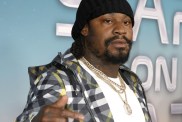Another living legend in attendance at last week’s Plus Camerimage festival in Bydgoszcz, Poland, Alan Heim is the Academy Award-winning editor behind films like Bob Fosse’s All That Jazz, Milos Foreman’s Hair and, more recently, Nick Cassavetes’ The Notebook. A recipient of the festival’s Lifetime Achievement Award, Heim took a moment to speak with ComingSoon.net about his incredible life in motion pictures.
A rare blend of charm and sincerity, Heim openly recalls his friendship with the bigger-than-life genius of the late Bob Fosse and goes into frank detail about what he experienced during the infamously re-edited American History X, including one day when he and star Edward Norton nearly came to physical blows.
If you missed our previous conversations with fellow 2012 Camerimage Lifetime Achievement Award recipients, you can check out David Lynch by clicking here and Vadim Yusov by clicking here.
CS: Clearly, one of the most impactful moments in your career was the first time you met Bob Fosse. How did that come about?
Alan Heim: I got a call one day in New York City, where I lived most of my life until about 18 years ago. It was a call from my friend who was a producer and he was working on a one-hour TV special that Fosse was directing called “Liza with a ‘Z'”. It was live at the [Lyceum] Theater. It was a beautiful looking theater. It was a black tie thing, filmed in one hour with nine cameras. Nine 16mm cameras. Six or nine, I don’t really remember. A lot of 16mm cameras. I was lit theatrically, which led to certain problems because it didn’t translate well to television. Only a few years ago were they able to make a DVD of it. It was just not seen for many, many years. Bob won an Emmy for it. It was the year he had won an Emmy, a Tony and an Oscar. So I met Bob at a rehearsal studio. It’s the one you see in “All That Jazz.” It’s the same rehearsal studio, Broadway Arts. I went up to see him and my wife at the time — my late wife — had seen “Cabaret” at the Ziegfeld Theater the night before. She said, “You really gotta see this movie!” I said, “Eh, I don’t know if I like movie musicals that much.” So I went up and met Bob and was dazzled by the energy in the room. The dancers sliding across the floor and we’re standing in the middle of the room talking. The dancers would come and slide right up to the edge of our feet. Just the thrill of being there was astounding. We talked and Bob was — I’m not a musician, but I was a music editor and I have a very good ear. I can make material work with music and I can make music work with material. I can do some very fancy cutting. Maybe not what they can do today, but this was on film and I could do a lot of stuff — Bob was really disappointed that I wasn’t actually a musician and couldn’t read music. I really wasn’t sure if I would get the job. But that night I went to see “Cabaret” and I came home to my wife and said, “I really, really want this job. Boy, do I want this job.” The next day they called me and, as I said, I did it. The film won an Emmy. I believe I was nominated for an Emmy and couldn’t go the awards. It didn’t win. A while later, Bob sent me the script of “Lenny.” It was the same effect. I read the script in the evening, the same day that I got it. My wife had gone to sleep early. I think she had a cold or something. I went and said, “You gotta read this script.” She said, “I’ll read it in the morning.” I said, “You have to read it now! I want to do this movie!”
CS: And moved from there on to your first feature together.
Heim: Then we did “Lenny” which, to me, was a seminal film. For one thing, it was a great script. It was written by Julian Barry, who wrote the play of “Lenny.” My memory of the whole thing is that Dustin Hoffman was quite good but, like many actors, wanted to be liked. Lenny Bruce just did not want to be liked. He didn’t care about that. When we started putting the film together, Dustin’s performance kind of lagged. He was asking the audience for stuff rather than telling them stuff. I came up with the idea of — the script is very complex. There was lots off intercutting — I came up with the idea of making it even more intercut. So that what triggered a comedy routine was not just one thing but several things. We broke up the comedy routines and found that, the shorter the comedy routines got, the more exciting the film got and the better Dustin’s performance was. He got nominated for an Academy Award. He hated the movie. Hated it. Bob did theatrical stuff in-between. Much to my loss because I would have loved to work with him all the time forever. Then he did all that jazz which took a lot of the techniques that we had developed in “Lenny.” He tried to write them into the movie and did, fairly well. He wrote it with Robert Alan Arthur, who was a great producer and writer in the “Golden Age” of television. I know your recorder can’t see quotes. I’m putting quotes around “Golden Age.” He came out of the same group as Paddy Chayefsky, Delbert Mann and Sidney Lumet. All those wonderful, wonderful producers/directors/writers who did a show every couple of weeks almost. Both Bobs wrote the script. Then, oddly enough when we came into the cutting room and tried to apply some of the same techniques we had done in “Lenny,” it was harder to do. It was harder to do because the film was so structured in a way. But I think the film worked quite well.
CS: That’s pretty hard to deny. Then came “Star 80”?
Heim: Then came “Star 80,” which was just a tough, tough movie for everyone involved. Grim subject. Bob came into the cutting room one day while we were finishing “All That Jazz.” He said, “this is the film I want to do next.” It was an article from the Village Voice, which I had read, about Dorothy Stratten and Paul whatever-his-name-was. I thought it was a pretty grim subject, but it dealt with Bob’s interests. Show business. Manipulation of women. Stuff I would never have known anything about if I hadn’t worked with Fosse. It was an invitation to a life that I very exciting. Anyway, he did that movie and was very disappointed by the reviews, as was I. But Bob really got depressed. Luckily, he had some theatrical stuff to do and pulled himself back together. He wanted to do a film about Walter Winchell, but he died suddenly. I’m always disappointed that we were supposed to have lunch and I had cancelled because I had a film coming up and I had a meeting on that. I cancelled and we never scheduled the meeting again. Then he died while I was on location. I miss him. He was a great talent and just a wonderful and wild human being. He was interesting. He did something that, I think, all directors really want to do. He made you want to give him your best work. It wasn’t as if he ordered it. You just wanted to do it. Every department felt the same way. I mean, people had gripes with him. He could be very mercurial. I had my own problems and all that jazz at one point. But once you were on the team, you would work very hard to do the best wok you possibly can. I’ve known directors who have said, “Don’t trust anyone who’s getting a credit. If they’re getting a credit, they’re only interested in their own little department. The cameraman, the editor is only interested in that. The actors only care about their performance.” That last one might be true or not, but that’s a very short-sighted way of looking at a movie. A movie is a communal effort. If you can get everybody to give you their best, you’ll get the best movie you possibly can. Bob Fosse was very capable of doing that.
CS: On the flip side of that, I wanted to ask about “American History X,” which has become somewhat infamous with director Tony Kaye disavowing the final cut.
Heim: Yeah, the final version. I was not involved with the final version. “Infamously,” yes
So, I was asked to do the movie, but I had a commitment. I’m not even sure I read a script on that one. I had a commitment to do something else and, just as I was finishing that up, I got a call from Tony Kaye. He wanted to meet for dinner. I don’t know why, but I picked a restaurant that was a vegetarian restaurant. I didn’t know Tony was a vegetarian. It was just a coincidence. We had a meeting and he told me that he wasn’t very happy with the other editor, the previous editor. He asked me I wanted to take over the film. It’s awkward, to take over someone else’s project. I’ve been fired. I’ve replaced people. I much prefer replacing people, but it’s still awkward. Much better than being fired, though. Anyway, Tony and myself and there was another editor who was an English friend of Tony’s. He was working on the film, too. When we finished a cut that we liked, we showed it to Tony. Tony liked it. We said we’d like to go back and do a couple little fixes and rearrangements and Tony said okay, but he wanted to show it to Edward Norton and to the writer. Tony had fired the cinematographer on the first day, by the way, and took over the camera so Ed was directing the actors. The film was very much improv and, I think, showed it in places. A lot of places. At some point, he showed it to the writer and Edward Norton and they hated it. I don’t want to go into why they hated it, but they viewed this film as an epic. It just didn’t have enough sand to be an epic. It’s a good, strong movie. A terrifying movie. What happened then was that Edward insisted on coming into the editing room. I said no because of something personal that had happened between us. When he saw my cut, he said that I had missed every nuance of his performance and it pissed me off. So because of the role, he was all bulked up at the time. He’s eight or nine inches taller than I am anyway. I really thought about hitting him. Ripping his throat out. Then I said, “Nah.” But he ignored my hand when I put out my hand to meet him. Scary. It had never happened to me before. I just didn’t want to work with him, so I had him working with my assistant. Tony was sitting with me and storming angry. He punched a wall, tore apart the closet. He broke his hand over one weekend because he was so angry hitting a wall. He felt his film being taken away. Eventually, Edward insisted on working with me and I said no. I left and Jerry Greenberg, who’s a friend of mine became the next of three Academy Award-winning editors working on the movie serially. I’ve never heard of that. I’ve worked with other editors on a film, but never had them laid out serially. Jerry had the patience to stick it out with Edward. He made the film you see now. But Tony was taking strange ads in The Hollywood Reporter and Variety. Full page ads. He was a graphic designer, too. A very talented man. They had strange quotes. I think he was quoting John Lennon. A lot of strange quotes, but all of them were an attack on New Line for letting Edward take over the movie. Later, I spoke with the president of New Line. I said, “Given that Tony was a first time director and that Edward was a rising star, why did you let Edward take over the movie anyway?” He said that Edward had convinced him that my version — the version that we all liked at that point — gave people the motivation to be skinheads. What I wanted to do and what I did do was move the last scene of the movie, which kind of explains the characters’ motivation. The scene where he discovers that his father has been killed putting out a fire in a black neighborhood. I put that early in the movie. Somewhere in the first 15 minutes. That let you really understand this character. Otherwise there was just nothing that made you understand it. Edward said it was too much and the audience would become skinheads. It was just ridiculous. I know we had one screening of that version. It was thrilling. When they curbed the kid and stepped on his head, you could feel everyone in that theater take a tremendous deep breath. I really had a vision of the building imploding from the force of everybody [gasping]. It was one of the most powerful moments in any film I’ve ever worked on. I mean, the moment is still powerful as Hell, but they changed it. It’s a different movie. I find it softer than it used to be.
(Photo Credit: Dimitri Halkidis / WENN)










